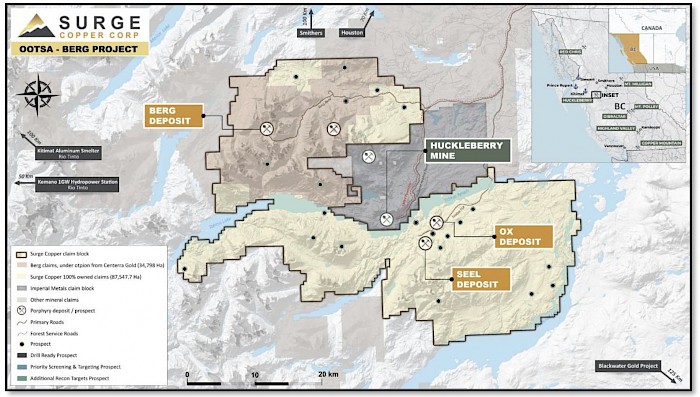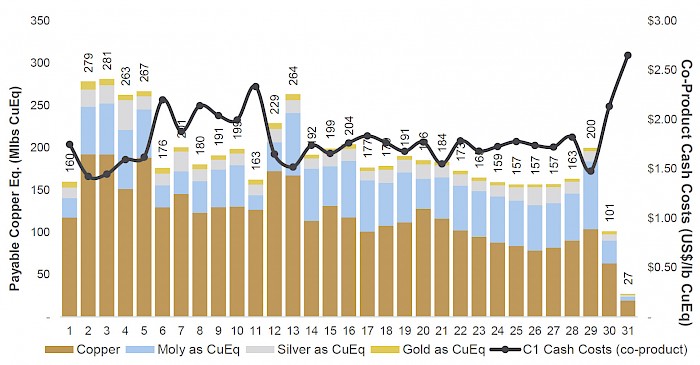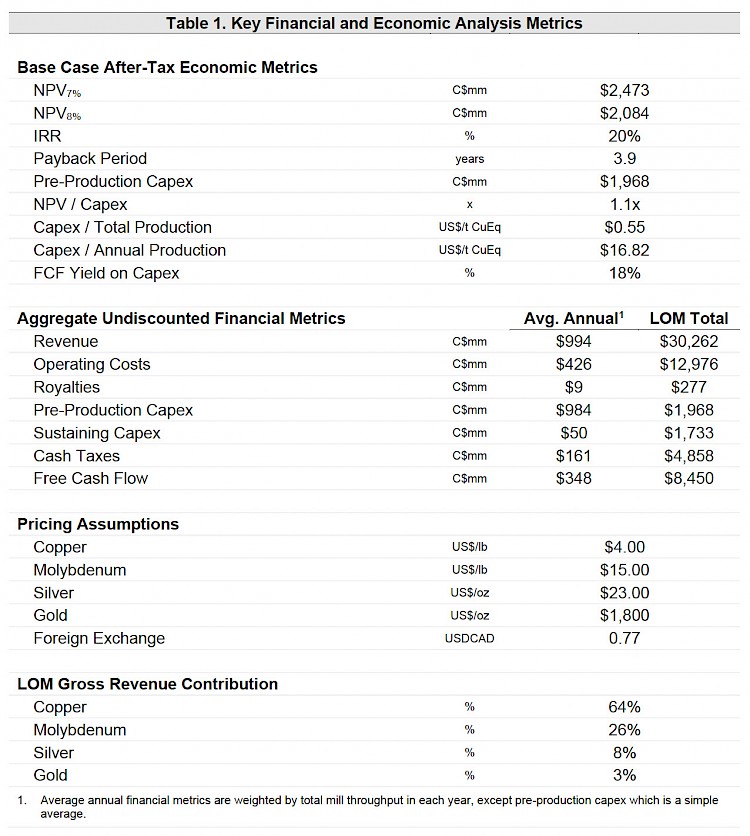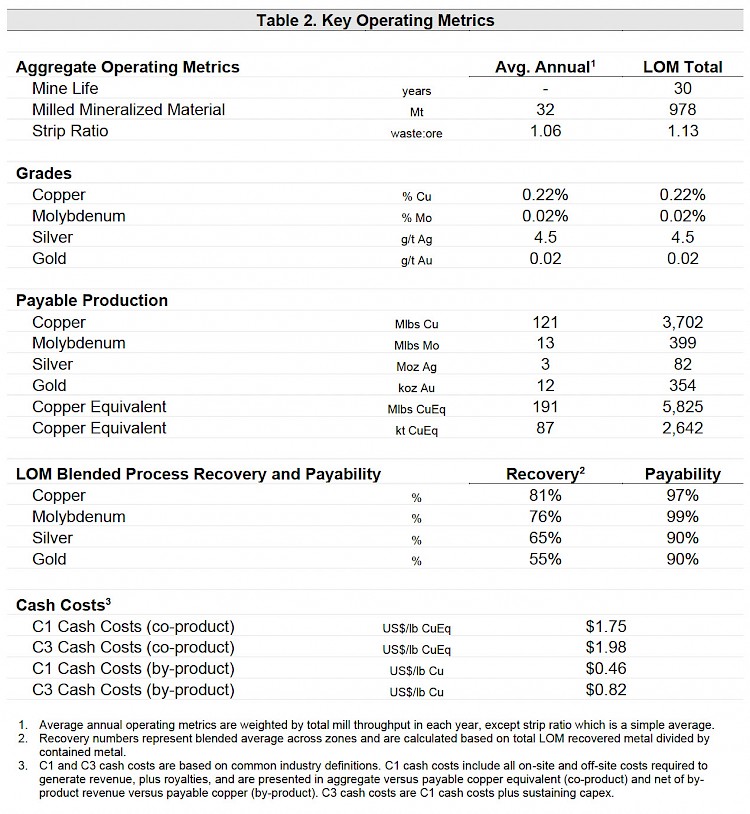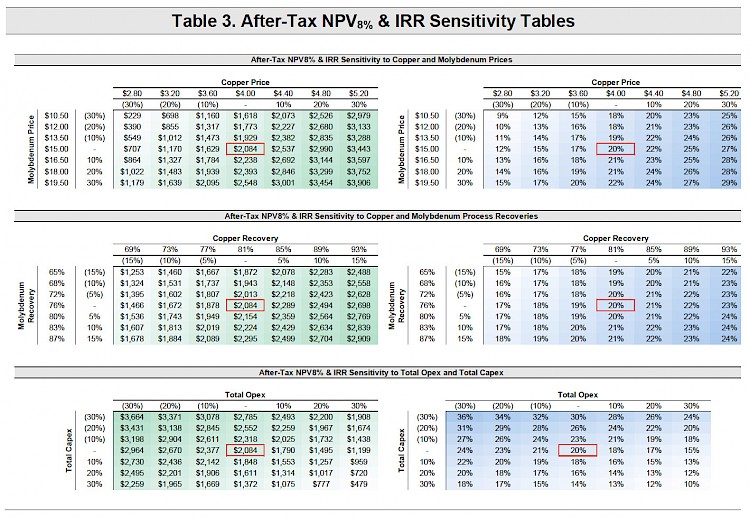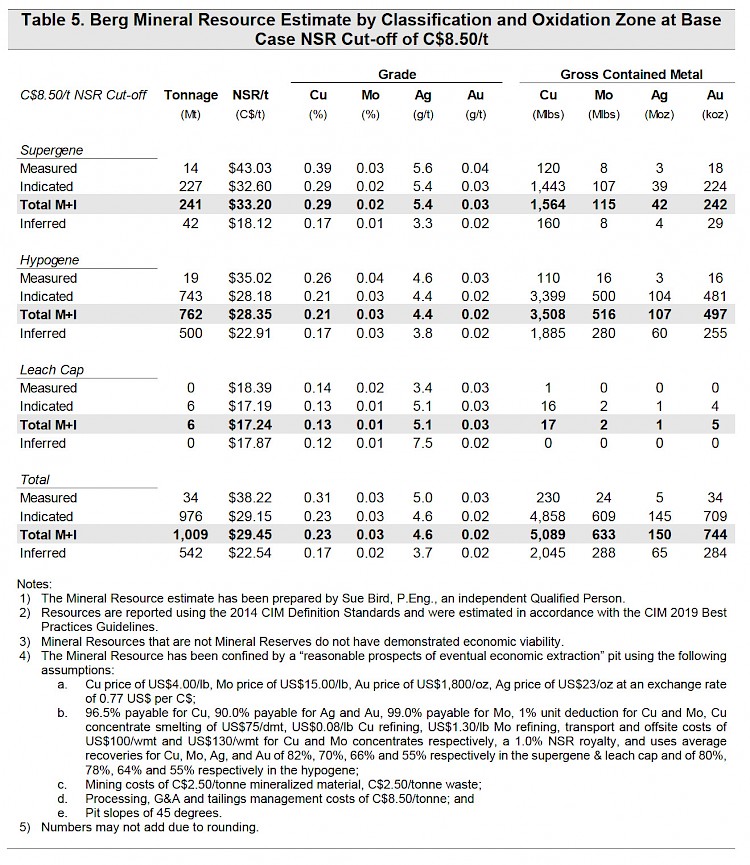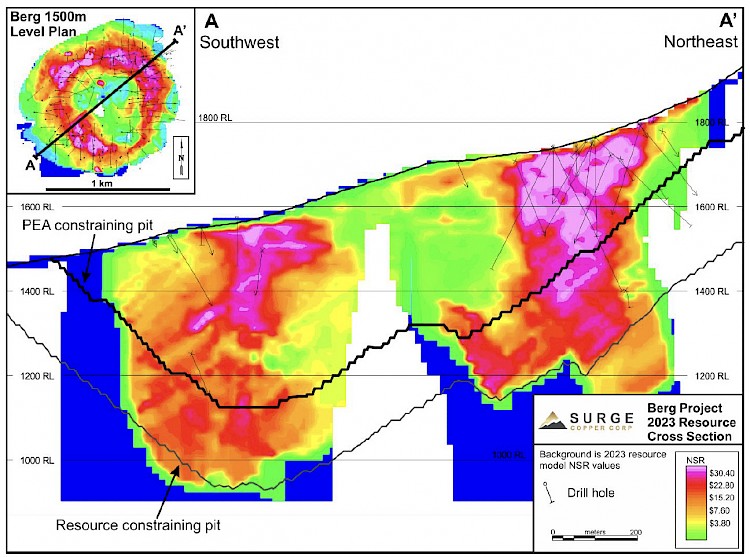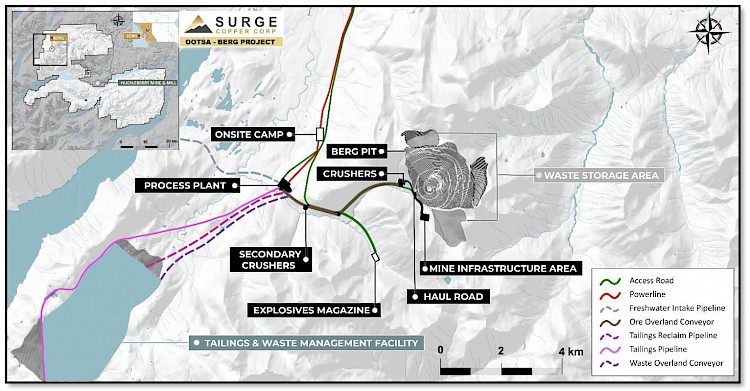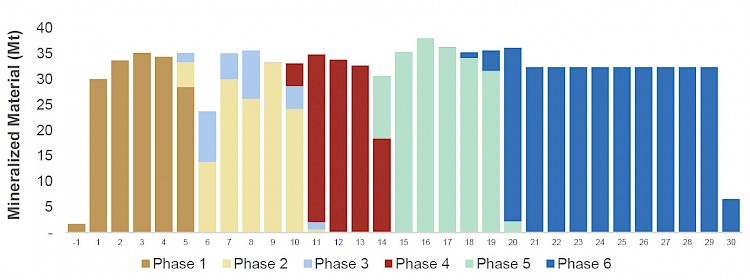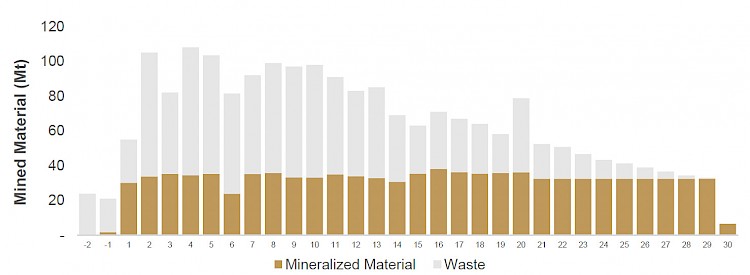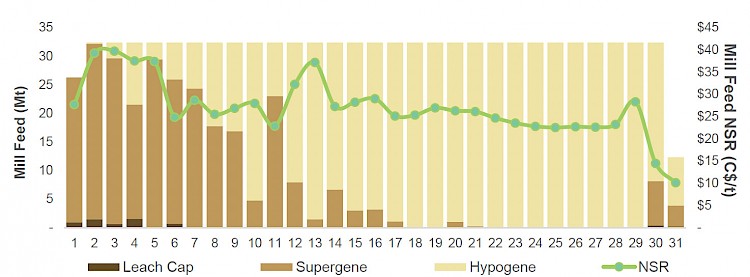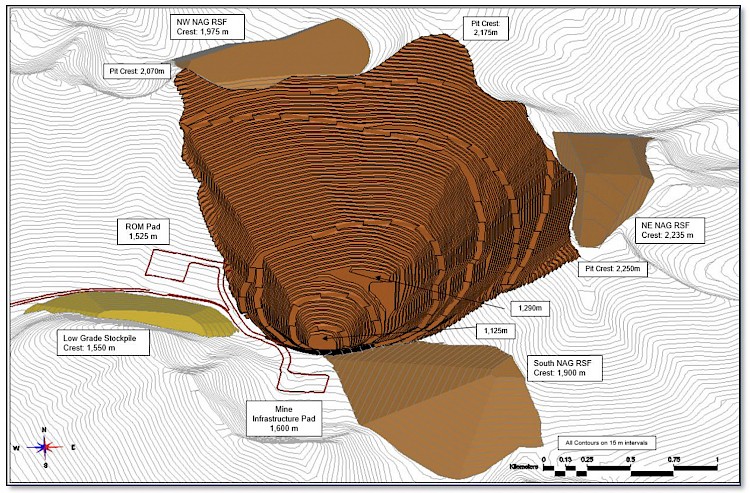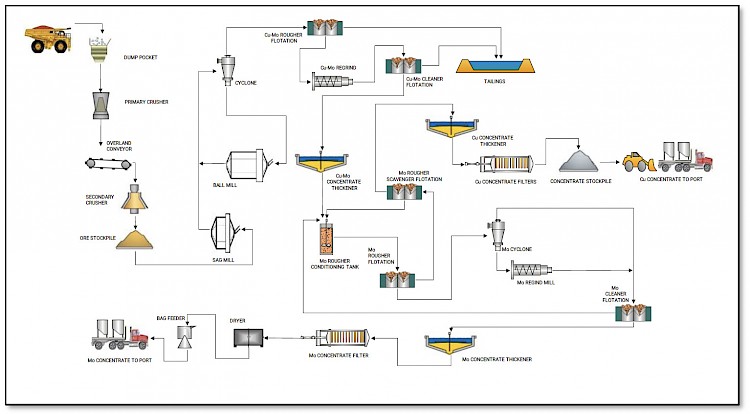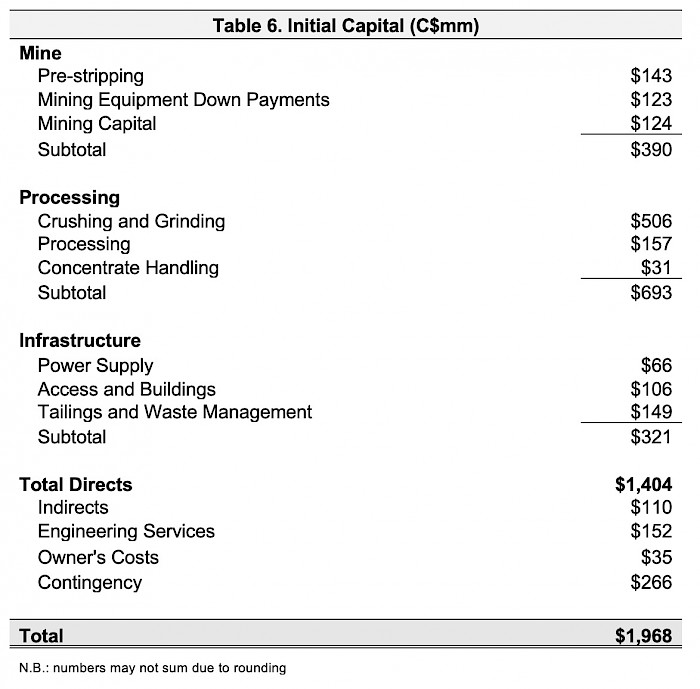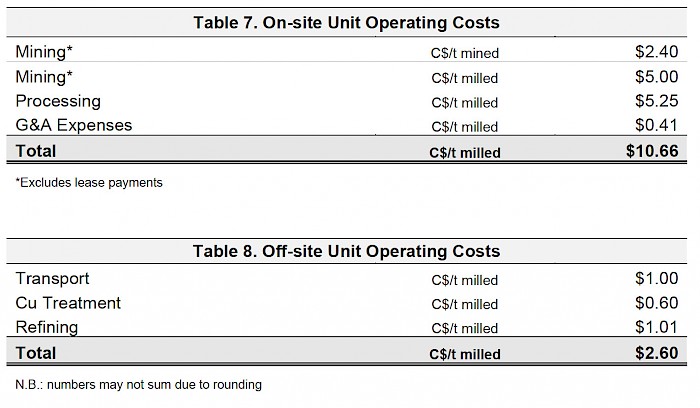Large-scale, long-life, stand-alone greenfield development project
with simple design and high outputs of critical minerals located in a
safe jurisdiction with world-class infrastructure
- Base case after-tax NPV8% of C$2.1 billion and IRR of 20% based on long-term commodity price assumptions of US$4.00/lb copper, US$15.00/lb molybdenum, US$23/oz silver, and US$1,800/oz gold plus foreign exchange of 0.77 USDCAD
- 30-year mine life with total payable production of 5.8 billion pounds (2.6 million tonnes) of copper equivalent (CuEq)1, including 3.7 billion pounds (1.7 million tonnes) of copper
- Updated mineral resource estimate includes combined Measured & Indicated resource of 1.0 billion tonnes grading 0.23% copper, 0.03% molybdenum, 4.6 g/t silver, and 0.02 g/t gold, containing 5.1 billion pounds of copper, 633 million pounds of molybdenum, 150 million ounces of silver, and 744 thousand ounces of gold, plus an additional 0.5 billion tonnes of material in the Inferred category
- Mineable inventory contains 978 million tonnes grading 0.22% copper, 0.02% molybdenum, 4.5 g/t silver, and 0.02 g/t gold, and consists of 80% Measured and Indicated resources, with the first 5 years of steady-state production containing 162 million tonnes with an average grade of 0.30% copper, 0.03% molybdenum, 5.7 g/t silver, and 0.03 g/t gold
- First 10 years of steady-state production: annual payable production of 220 million pounds (100 kilotonnes) of copper equivalent including 151 million pounds (69 kilotonnes) of copper
- Life of mine annual payable production of 191 million pounds (87 kilotonnes) of copper equivalent including 121 million pounds (55 kilotonnes) of copper
- Life of mine C1 co-product cash costs of US$1.75/lb Payable CuEq and by-product cash costs of US$0.46/lb Payable Cu
- Low life of mine strip ratio of 1.1 inclusive of pre-stripping requirements of 43 million tonnes
- Pre-production capex of C$2.0 billion, implying capital intensity metrics including NPV / Capex of 1.1x, Capex / Annual Production of US$16.82/t Recoverable CuEq, Capex / Total Recoverable Production of US$0.55/t Recoverable CuEq, and Average FCF Yield on Capex of 18%
- Low estimated costs of approximately C$6-8 million and rapid 18-month timeline to advance project to PFS stage
- Simple project design includes a single open pit, overland conveyor system, concentrator process plant and tailings and waste management facility, and ties into existing infrastructure including roads and hydroelectric gridpower
1. All references herein to copper equivalent (CuEq) are on the basis of recovered or payable metals, as indicated, with such recovered or payable metals converted into copper equivalent based on their respective price ratios using the long-term metal prices used in the PEA of US$4.00/lb copper, US$15.00/lb molybdenum, US$23.00/oz silver, and US$1,800/oz gold and with the formula CuEq (lbs) = Cu (lbs) + 3.75 * Mo (lbs) + 5.75 * Ag (oz) + 450 * Au (oz).
June 13, 2023, Vancouver, British Columbia – Surge Copper Corp. (TSXV: SURG) (OTCQX: SRGXF) (Frankfurt: G6D2) (“Surge” or the “Company”) is pleased to announce the results of its Preliminary Economic Assessment (the “PEA”), prepared in accordance with National Instrument 43-101 – Standards of Disclosure for Mineral Projects (“NI 43-101”), for the Berg Project located in central British Columbia within the traditional territories of the Cheslatta Carrier Nation, Wet’suwet’en First Nation, and Wet’suwet’en – including communities of Skin Tyee, Nee Tahi Buhn, and Witset. The PEA was completed by Ausenco Engineering Canada Inc. (“Ausenco”) and is based on an updated mineral resource estimate completed by Moose Mountain Technical Services Inc. (“MMTS”). The PEA is the first economic study prepared in accordance with NI 43-101 on the Berg Project and represents a significant milestone in the advancement of the Berg Project and the Company’s overall strategy in the combined Berg-Ootsa district. The Company is currently earning a 70% interest in the Berg Project from Centerra Gold.
All figures presented herein are on an unlevered, 100% basis, all currency numbers are either United States dollars (US$) or Canadian dollars (C$) as specified, all tonnes refer to metric tonnes, and all ounces refer to Troy ounces. The PEA is preliminary in nature and includes Inferred Mineral Resources that are considered too speculative geologically to have the economic considerations applied to them that would enable them to be categorized as Mineral Reserves, and there is no certainty the PEA will be realized.
Leif Nilsson, Chief Executive Officer, commented: “The Berg Project now represents one of the largest primary copper development projects in Canada, and this PEA confirms some of the unique features and key selling points of the project, including: 1) the potential for a simple, stand-alone, large-scale open pit mine and traditional concentrator flow-sheet which can produce high outputs of metals critical for the global energy transition (including copper and molybdenum), located in a safe jurisdiction with world-class infrastructure and a strengthening fiscal and permitting environment, 2) the ability to tie-in to existing hydroelectric grid infrastructure and electrify energy-intensive components of the operation such as material transport via overland conveyors, resulting in a low carbon footprint per unit of metal output, and 3) a robust economic return profile under a variety of long-term metal pricing assumptions. We believe these are among the most important characteristics for large-scale copper development projects, and that the Berg Project compares very favourably against similar-scale development opportunities globally. Additionally, the climate within Canada toward the development of strategically significant projects such as this is clearly improving, as evidenced by provincial and federal efforts to streamline permitting processes, and various incentives aimed at critical minerals projects, including the recently announced 30% refundable tax credit on capital costs for critical minerals processing equipment, which was not included in the PEA but would be expected to positively impact the base case economics. Given the significant multi-decade production volumes of both copper and molybdenum, and the fact that most primary copper development projects globally are copper-gold or copper-cobalt, we believe Berg is well positioned as one of the most robust copper-molybdenum development projects globally. Surge plans to advance the Berg Project toward pre-feasibility while continuing to explore the surrounding district, which we believe has significant untapped exploration potential and the ability to grow from what is already one of the largest copper districts in Canada.”
Berg PEA Summary
The PEA was initiated in late 2022 after the completion of a broad set of trade-off studies led by Ausenco which focused on infrastructure opportunities and alternatives present in the Berg-Huckleberry-Ootsa district, spanning material movement technologies and logistics, electricity supply options, and tailings and waste management facility siting options. The study is also underpinned by significant metallurgical testwork completed on material from the Berg deposit by G&T Metallurgical Services Ltd. (now ALS Metallurgy), which demonstrated that conventional flotation processes can be used to produce marketable copper and molybdenum concentrates.
The PEA outlines a large, open-pit mining operation which, over the course of 31 years, would extract a mineable inventory to provide a mill feed of approximately 978 million tonnes with an average grade of 0.22% copper, 0.02% molybdenum, 4.5 g/t silver, and 0.02 g/t gold. The mine is developed in multiple phases, focusing on early extraction of the higher-grade portions of the deposit in the supergene enrichment zone. Mining is performed by way of conventional truck and shovel operations, with run-of-mine mill feed and certain volumes of waste rock crushed and transported via a 3.4-kilometre electrically powered overland conveyor system from the mine to the process plant located at 400 metres lower elevation to the west of the mine site. The mill and concentrator process plant will operate at a 90,000 tonnes per day nominal capacity and will produce separate copper and molybdenum concentrates via a conventional sulphide flotation and molybdenum separation flowsheet. Process tailings and potentially acid generating (“PAG”) waste rock will use co-storage of tailings and waste rock together for permanent storage in a tailings & waste rock management facility (“TWMF”) located southwest of and adjacent to the process plant. Final copper concentrate products containing precious metal by-products will be transported by truck to one of several nearby deep seaports along the Pacific coast for sale to end customers, and molybdenum concentrates will be transported by truck to a rail load out location for toll roasting within continental North America before final sale of molybdenum oxide to end customers globally. The study outlines a two-year construction period with pre-production capital expenditures of just under C$2.0 billion, sustaining capital expenditures over the life of mine of $1.5 billion, reclamation and closure costs at the end of the mine life of C$200 million, and total taxes paid over the life of mine, on an undiscounted basis, of C$4.9 billion.
Mark Wheeler, P.Eng., Vice President of Projects, commented: “This maiden PEA represents a fantastic starting point for the further development of the Berg Project and we look forward to sharing the details with local communities, specifically the Wet’suwet’en First Nation, Clans of the Wet’suwet’en, and Cheslatta Carrier Nation in order to ensure participation in all aspects of the project going forward. The PEA shows a long-life development project with the opportunity to have significant benefits for the local communities across the region.”
Figure 1. Regional Map
Figure 2. Payable Production and Co-Product C1 Cash Cost Profile
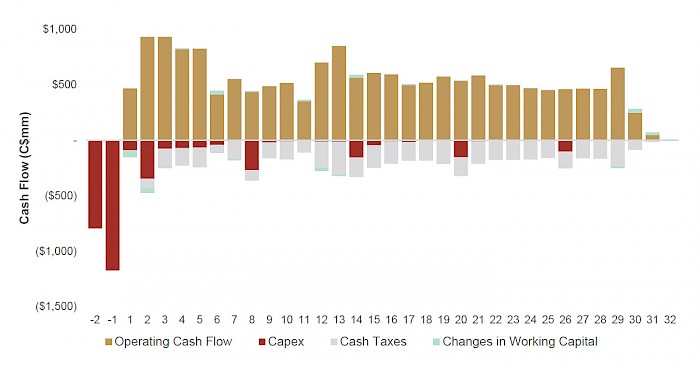
Figure 3. Cash Flow Components
Mineral Resource Estimate
In conjunction with the PEA, a new mineral resource estimate (“MRE”) has been completed on the Berg deposit with block model estimation performed by Sue Bird, P.Eng., of MMTS, an independent Qualified Person as defined by NI 43-101. The MRE benefits from 2,855 metres of new drilling completed by Surge in 2021, 7,261 new gold assays collected by Surge from historical core and pulp samples during 2022 and 2023, improved geostatistical modelling of silver in the deposit, and improved metallurgical recovery assumptions based on an extensive review of historical metallurgical testwork by Ausenco and Surge. The MRE has an effective date of June 7, 2023.
Data from 210 core holes totalling 54,384m of drilling was used for the resource estimate. Domains of mineralized material were created for the oxide, supergene, and hypogene zones, with the hypogene material further defined by lithology. The domains were trimmed to the overburden surface and by un-mineralized assays. Copper, molybdenum, silver, and gold grades were estimated using capped assays composited to 5m intervals. The estimation block size is 15x15x15 metres with grades estimated by ordinary kriging and requiring the composites and the model domain to match. Outlier restriction of the composite is also used during interpolation to ensure that the modelled tonnage and grade are not biased compared to the de-clustered composite data. The bulk density has been assigned by domain based on the mean of 3,111 samples.
Classification is based on the variography to define the necessary drillhole spacing. Only drillholes since 2007 have been used to define the drillhole spacing. Classification criteria are summarized in Table 4 below.
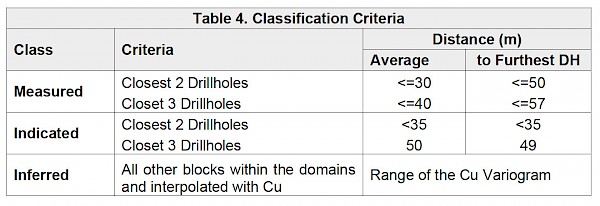
The MRE is summarized in Table 5 below. The resource is constrained by an open pit with a “reasonable prospect of eventual economic extraction” using a cutoff of CDN$8.50/t and the parameters as defined in the notes to Table 5. Mineral Resources that are not Mineral Reserves do not have demonstrated economic viability.
Figure 4. Berg Resource Cross Section Showing Resource Pit and Mineable Inventory Pit
Infrastructure & Site Layout
The site is currently accessible by road via an approximately 100-kilometre-long network of forest service roads which begin at the Trans-Canada highway at Houston, BC. This existing corridor, parts of which also service the Huckleberry mine site and the Company’s Ootsa exploration camp, provides both vehicular access as well as access to the provincial electricity grid at the Houston substation or other options in close proximity, to provide the required 105 MW of electrical power. An additional 16 km of low-elevation access road will be required for permanent access to the process plant, mine site, and the 330-person camp facility to house workers on a rotating shift basis.
The PEA has made significant efforts to minimize the overall project footprint and infrastructure components including the process plant, mining facilities, and TWMF. The layout design envisions the process plant being located at an elevation approximately 400 metres below the mine and crusher facilities allowing for low-energy-intensity gravity-assisted conveyance that will be routed in conjunction with the mine access road. The TWMF has been located in near proximity to the process plant while taking advantage of natural topography to minimize dam fill material and overall footprint. Process tailings will be placed against three embankments creating beaches toward the centre where the PAG waste rock will be stored subaqueously.
Figure 5. Schematic Layout of Key Components of Site Infrastructure
Open Pit Mine Plan
The open pit mine design, production scheduling, and cost estimating has been completed by MMTS and envisions a large-scale conventional drill-blast-load-haul open pit operation. The mineral inventory included in the mine plan is a subset of the MRE, targeting 978 million tonnes of mill feed, grading 0.22% Cu, 0.02% Mo, 4.5 g/t Ag, and 0.02 g/t Au, at a 1.1:1 waste:resource LOM strip ratio.
Mining of the open pit has been segregated, designed, and sequenced into six separate phases or pushbacks, targeting higher-value areas of the deposit earlier in the mine life, with some stockpiling of low-grade material for future mill feed. The production schedule produces an overall mill feed of 32.4 million tonnes per annum over the 30-year mine life while moving a maximum annual rate of 38.0 million tonnes of mineral inventory in year 16 and a maximum total mining rate, inclusive of waste material, of 108.0 million tonnes in year 4. Each phase has implemented specific access routes and ramp requirements to ensure operability for all pushbacks.
Rock is intended to be largely drilled and loaded using a fleet of electrically operated drills and shovels operating on 15 metre benches. Mineralized rock is then to be delivered to a run-of-mine crusher facility located directly adjacent to the open pit using a fleet of 230-tonne payload trucks, owned and operated by the Company, and transported 3.4 kilometres via downhill electric conveyor to the process plant location. While the current mining plan envisions a diesel-powered haul truck fleet it is expected that, at the time of a construction decision, sufficient electric alternatives will be available for purchase. Waste rock is intended to be stored in permanent facilities directly adjacent to the pit or within the TWMF with additional certain volumes being used directly for the construction of dam fill material.
Figure 6. Mine Plan by Phase
Figure 7. Mine Plan by Material Type
Figure 8. Mill Feed by Mineralized Material Type
Figure 9. 3D Schematic of Final Pit Shell
Metallurgical Testwork and Mineral Processing Flowsheet
Significant metallurgical test work has been completed on material from the Berg deposit during multiple programs primarily between 2008 and 2010 by G&T Metallurgical Services Ltd. (now ALS Metallurgy). These testwork programs involved approximately 2.3 tonnes of material across 18 composite samples representative of different volumes, average grades, rock types, and weathering zones within the deposit. The testwork programs spanned both bulk concentrate and molybdenum separation tests and demonstrated the ability to produce separate marketable copper and molybdenum concentrates using conventional process flowsheets. For purposes of the PEA, a logarithmic regression analysis was performed on testwork data to develop metallurgical process recovery formulas that relate recoveries to head grades within the leach cap, supergene, and hypogene weathering zones of the deposit. Based on these formulas, the resulting total life of mine recoveries for copper, molybdenum, silver, and gold in the PEA are 81%, 76%, 65%, and 55%, respectively.
Figure 10. Schematic Diagram of Process Flow Sheet
Capital and Operating Costs
The PEA considers a capital cost estimate created by Ausenco on the basis of an EPCM approach to development. Where possible the estimate makes maximum use of existing infrastructure such as road and grid power. The estimate also includes a contingency of 20% on all direct and indirect capital costs with some specific items treated with less contingency based on confidence of recent quotes and information provided by equipment suppliers such as mine development costs using a 10% contingency rate. It has been assumed that the construction period and initial capital will be spread across a two-year construction period and mining equipment capital has been estimated as leased, with a 20% down payment upon arrival and lease payments over 5 years. Sustaining capital over the life of the mine has been estimated at C$1.7 billion, consisting primarily of mining fleet lease expense, maintenance, and TWMF construction and includes a closure cost estimate of C$200 million.
Initial capital estimates include:
Processing, mining, and G&A operating costs have been built up from a first principles basis using recent benchmark data with certain items having quoted and available unit rates for estimation purposes. It has been estimated that fifty percent of the workforce will be local within the region and all hourly staff will operate on a rotating shift basis. All operating costs have been estimated on the basis of an owner-operated project resulting in a mining operating cost of $2.40/tonne mined over the life-of-mine of the project.
Total Operating Costs are broken down as follows:
Taxation & Royalties
The PEA models provincial mining taxes in accordance with the British Columbia Mineral Tax Act, and combined provincial and federal income taxes. The provincial mining taxes include a 2% tax on net current proceeds, which is a prescribed gross profit measure, and a 13% tax on net revenue, which is a prescribed profit measure inclusive of recoupment of capital expenditures and certain other deductions and credits including the 2% tax paid. Combined provincial and federal income taxes are modelled as a combined rate of 27% levied against a taxable income measure which includes deductions for provincial mining taxes paid, and accelerated depreciation charges for eligible capital expenditures. Importantly, the PEA does not take into account any potential economic benefits which may arise as a result of the new 30% refundable investment tax credit on the capital costs of machinery and equipment, including certain industrial vehicles, acquired to extract and process critical minerals which was announced by the Government of Canada in its March 28, 2023 Federal Budget. The PEA estimates total taxes paid over the life of mine of C$4.9 billion including C$3.1 billion to the Province of British Columbia and C$1.8 billion to the Government of Canada, implying an estimated life of mine tax rate on taxable income of approximately 41%.
The PEA also models a 1% net smelter return royalty payable to Royal Gold Inc., totalling C$277 million over the life-of-mine.
Indigenous Nations Stakeholders
The Berg project is within the territories of several Nations and communities in the region with First Nation members using the land for traditional purposes. Surge has had ongoing relationships for more than a decade with the Cheslatta Carrier Nation and Wet’suwet’en Nations. The company and personnel look forward to sharing the results of the PEA in order to foster a better understanding of how the project may affect local communities such that each Nation can actively participate in the planning and development process and the eventual benefits that would come from the Berg mine development.
Environmental and Permitting
Surge is committed to reducing the overall environmental and carbon footprint for the Berg mine development. As such the project envisions taking advantage of BC’s clean hydroelectric grid and eliminating diesel haul equipment by utilizing electric downhill conveyor systems with the potential to generate electricity using the potential energy of mined materials in transit to the process plant and storage locations. Future studies will continue to advance the initiative with the intended use of in-pit electric haul trucks and mining service equipment as it becomes available to the market. Due to these unique geographical features and opportunities of the Berg Project, the Company believes it has the potential to deliver among the lowest carbon emissions per unit of metal output among peer development projects.
The study work within the PEA has investigated the location of several key pieces of infrastructure for the advancement of the Berg Project. The Company will continue to progress and build out the environmental baseline that has been completed over the course of more than 10 years spanning several different operators at the Berg Project. The collection of additional baseline information targeting specific areas and watersheds will be outlined within the PEA. While the area in the direct vicinity of the designed open pit site is presumed non-fish bearing, downstream watercourses are presumed fish-bearing. Future efforts will focus on data collection in downstream areas to allow for the appropriate long-term sustainability of the overall operation. Additional work will be commenced immediately on long lead time baseline items such as hydrogeology, hydrology, surface water quality, and geochemistry to allow for sufficient time and data in anticipation of Provincial and Federal Environmental Assessment activities. It is anticipated that the details within the PEA will form the basis for initial discussions and engagement to begin the mine permitting process.
Opportunities
Following the PEA, the Company sees several areas of opportunity to continue to expand and improve the overall size and economics of the Berg Project, including:
- In-pit expansion of higher-grade zones: Certain volumes within the resource block model which host attractive grades are restricted by limited drilling, and opportunities exist to extend these zones, including expanding the constraining pit downward with additional drilling. In addition, certain volumes lack estimation of silver and gold due to limitations in historical assaying, which would likely see improvements in aggregate block grades with additional infill drilling.
- Near-resource expansion drilling: All drilling at Berg has been relatively shallow, and the deposit remains essentially unbounded laterally and at depth. Opportunities exist to extend the resource boundaries or make new discoveries with deep target drilling. In addition, ongoing analysis of regional geophysical data continues to support the potential for regional exploration, including within close proximity to the Berg deposit.
- Improved metallurgy: Metallurgical recovery assumptions utilized in the PEA are grounded in a significant corpus of historical testwork, and result in relatively modest life-of-mine recoveries across the various payable metals. With additional focused testwork and modern laboratory approaches and technologies, there may be opportunities to improve target metallurgical recoveries.
- Tax incentives: As noted above, total available tax incentives for projects like Berg may expand in future years, allowing for further optimization of economic return metrics.
Additionally, given the improving climate within Canada for the acceleration of the development of major critical minerals projects, the Company intends to work with various federal and provincial government agencies to assist with the development of the Berg Project, including:
- Natural Resources Canada and its Critical Minerals Centre of Excellence, which leads the development and coordination of Canada’s policies and programs on critical minerals, in collaboration with industry, provincial, territorial, Indigenous, non-governmental, and international partners. The Centre aims to advance critical mineral resources and value chains which are essential for a green economy, and works to promote foreign direct investment opportunities for Canadian critical mineral projects.
- Natural Resources Canada and its Indigenous Natural Resource Partnership program which seeks to increase the economic participation of Indigenous communities and organizations in the development of natural resource projects that support the transition to a clean energy future.
- The Canada Infrastructure Bank which can make direct investments across a project’s capital structure, and prioritizes investment in clean power including the generation, storage, and transmission of clean power.
Next Steps
The Company will file an NI 43-101 Technical Report in respect of the PEA on SEDAR within 45 days. The Technical Report will contain important details and background information not contained within this press release and will also include recommendations for future work to be undertaken to advance the Berg Project. At this time, the Company will highlight the following guidance in respect of future activities at Berg:
- Based on the robust economic results and low technical complexity of the project design as outlined in the PEA, plus the favourable location in central British Columbia adjacent to numerous other large-scale industrial installations, the Company believes the Berg project is positioned as a top-tier major copper-molybdenum critical minerals development opportunity globally and merits advancement to a pre-feasibility level of study and generation of initial mine reserves.
- The Company intends to proceed to the pre-feasibility study (“PFS”) stage in order to position the project to capture anticipated copper development demand and acceleration from the global energy transition, and as such will initiate the technical recommendations to do so, inclusive of technical work including geotechnical, hydrogeological, geochemical, metallurgical, and environmental baseline studies.
- The Company currently anticipates that the budget required to advance the project to the PFS stage will be relatively modest at approximately C$6-8 million (excluding corporate costs) as a significant portion of the PEA mine plan is based on Measured & Indicated resources and thus a drilling campaign focused solely on infill drilling is not expected to be extensive.
- The Company is planning additional drilling at Berg during the 2023 field season along with baseline environmental, geotechnical, geochemical, and metallurgical studies and more details on the Company’s next steps to advance the Project will be announced after the NI 43-101 Technical Report is complete.
Under the terms of the Company’s option agreement with Centerra Gold in respect of the Berg Project, the Company must complete expenditures of C$8 million and make certain share-based payments totalling C$5 million by December 2025. As of, December 31, 2022, the Company has completed expenditures of approximately C$5.7 million and has made share-based payments totalling C$4.4 million, with such total expenditures excluding the majority of the costs associated with the PEA. Upon completion of the 2023 field season along with additional work as outlined above, the Company anticipates being able to consider completing its earn-in and vesting its 70% interest in the Berg Project later this year, which will result in the formation of a new joint venture with both parties contributing pro rata from that point forward.
Participation in Upcoming Conference
The Company will be participating in the upcoming 121 Global Online Critical Materials conference from June 14-15. Additional information can be found at https://www.weare121.com/121-global-online-critical-materials/.
Qualified Persons
A team of Independent Qualified Persons (as such term is defined under NI 43-101) at Ausenco and MMTS has led the PEA and has reviewed and verified the technical disclosure in this press release, including:
Kevin Murray, P.Eng., of Ausenco is an independent QP for the process and infrastructure capital and operating cost estimation, and project financials.
Peter Mehrfert, P.Eng., of Ausenco is an independent QP for the metallurgical test work and recovery model.
Mohammad Ali Hooshiar Fard, P.Eng., of Ausenco is an independent QP for the tailings and waste rock management facility.
Scott Weston, P.Geo., of Ausenco is an independent QP for the environmental and permitting studies.
Sue Bird, P.Eng., of MMTS is an independent QP for the Mineral Resource Estimate.
Marc Schulte, P.Eng., of MMTS is an independent QP for the mine planning and cost estimation.
Dr. Shane Ebert P.Geo., President and VP Exploration at the Company is the Qualified Person for the Ootsa and Berg projects as defined by National Instrument 43-101 and has approved the technical disclosure contained in this news release.
Mark Wheeler, P.Eng., VP of Projects at the Company as well as a Qualified Person as defined by National Instrument 43-101, has supervised the preparation of the technical information in this news release.
About Surge Copper Corp.
Surge Copper Corp. is a Canadian company that is advancing an emerging critical metals district in a well-developed region of British Columbia, Canada. The Company controls a large, contiguous mineral claim package that hosts multiple advanced porphyry deposits with pit-constrained NI 43-101 compliant resources of copper, molybdenum, gold, and silver – metals which are critical inputs to the low-carbon energy transition and associated electrification technologies.
The Company’s flagship project is the Berg Project, in which it is earning a 70% interest from Centerra Gold. The Company has announced a PEA on the Berg Project which outlines a large-scale, long-life development project with a simple design and high outputs of critical minerals located in a safe jurisdiction near world class infrastructure. The PEA highlights base case economics including an NPV8% of C$2.1 billion and an IRR of 20% based on long-term commodity prices of US$4.00/lb copper, US$15.00/lb molybdenum, US$23.00/oz silver, and US$1,800/oz gold. The Berg deposit contains pit constrained 43-101 compliant resources of copper, molybdenum, silver, and gold in the Measured, Indicated, and Inferred categories.
The Company also owns a 100% interest in the Ootsa Property, an advanced-stage exploration project containing the Seel and Ox porphyry deposits located adjacent to the open pit Huckleberry Copper Mine, owned by Imperial Metals. The Ootsa Property contains pit-constrained NI 43-101 compliant resources of copper, gold, molybdenum, and silver in the Measured, Indicated, and Inferred categories.
On Behalf of the Board of Directors
“Leif Nilsson”
Chief Executive Officer
For further information, please contact:
Riley Trimble, Corporate Communications & Development
Telephone: +1 604 416 2978
Email: info@surgecopper.com
Twitter: @SurgeCopper
LinkedIn: Surge Copper Corp
https://www.surgecopper.com
Neither the TSX Venture Exchange nor its Regulation Services Provider (as that term is defined in the policies of the TSX Venture Exchange) accepts responsibility for the adequacy or accuracy of this release.
This News Release contains forward-looking statements, which relate to future events. In some cases, you can identify forward-looking statements by terminology such as "will", "may", "should", "expects", "plans", or "anticipates" or the negative of these terms or other comparable terminology. All statements included herein, other than statements of historical fact, are forward-looking statements, including but not limited to the Company’s plans regarding the Berg Property and the Ootsa Property. These statements are only predictions and involve known and unknown risks, uncertainties, and other factors that may cause the Company’s actual results, level of activity, performance, or achievements to be materially different from any future results, levels of activity, performance, or achievements expressed or implied by these forward-looking statements. Such uncertainties and risks may include, among others, actual results of the Company's exploration activities being different than those expected by management, delays in obtaining or failure to obtain required government or other regulatory approvals, the ability to obtain adequate financing to conduct its planned exploration programs, inability to procure labour, equipment, and supplies in sufficient quantities and on a timely basis, equipment breakdown, impacts of the current coronavirus pandemic, and bad weather. While these forward-looking statements, and any assumptions upon which they are based, are made in good faith and reflect the Company's current judgment regarding the direction of its business, actual results will almost always vary, sometimes materially, from any estimates, predictions, projections, assumptions, or other future performance suggestions herein. Except as required by applicable law, the Company does not intend to update any forward-looking statements to conform these statements to actual results.

